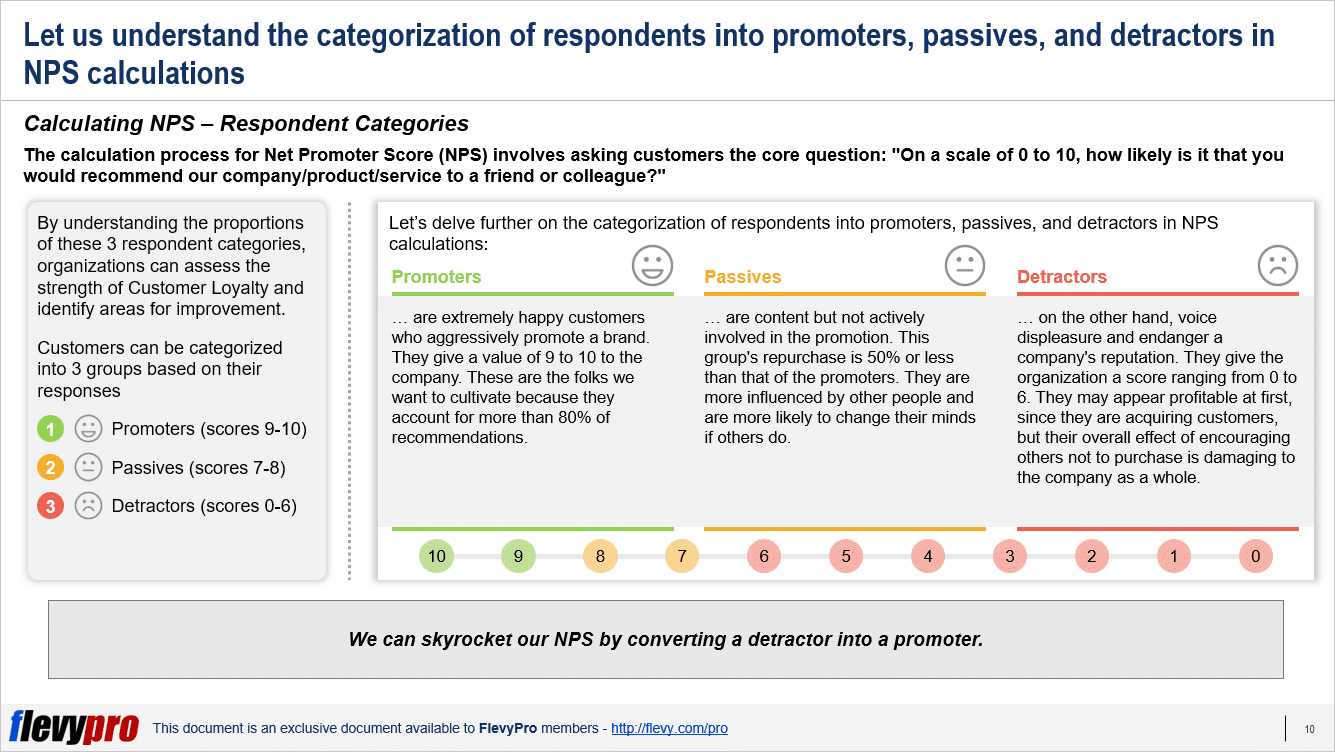Editor's Note: Take a look at our featured best practice, Product Management KPIs (32-slide PowerPoint presentation). Product Managers are responsible for defining the features or functions of a Product and for overseeing the development of the Product. The role of Produce Managers spans many activities from strategic to tactical and can vary based on the organizational structure of the organization. [read more]
Net Promoter Score (NPS)
* * * *
The Net Promoter Score (N
NPS respondents can be categorized into 3 groups:
- Promoters
- Passives
- Detractors
NPS is a significant metric that gauges customer loyalty and predicts organizational success. In Frederick F. Reichheld’s book “The Ultimate Question 2.0,” NPS is portrayed as a metric that goes beyond measuring customer satisfaction to provide valuable insights into customer loyalty.
The book emphasizes that customer loyalty is a key driver of organization growth and advocates the use of NPS to gauge customers’ likelihood of recommending a company, product, or service to others.
Despite the criticisms of its validity and effectiveness as a predictor of organizational growth, NPS is widely used by organizations to assess customer satisfaction thereby improving services. For instance, Fortune 500 companies include this in their customer development model to improve their goods and services and to monitor consumer happiness over time.
The calculation process for the NPS involves asking customers the core question:
“On a scale of 0 to 10, how likely is it that you would recommend our company, product, or service to a friend or colleague?”
NPS respondents are then categorized into groups depending on their scores.
Customer Respondent Groups
- Promoters (scores 9–10) are extremely happy customers who aggressively promote a brand. They give a value of 9 to 10 to the company. These are the folks we want to cultivate because they account for more than 80% of recommendations.
- Passives (scores 7-8) are content but not actively involved in the promotion. This group’s repurchase rate is 50% or less than that of the promoters. They are more influenced by other people and are more likely to change their minds if others do.
- Detractors (scores 0–6), on the other hand, voice displeasure and endanger a company’s reputation. They give the organization a score ranging from 0 to 6. They may appear profitable at first since they are acquiring customers, but their overall effect of encouraging others not to purchase is damaging to the company as a whole.
NPS is calculated by subtracting the percentage of detractors from the percentage of promoters, yielding a score between -100 and +100.
By understanding the proportions of these 3 respondent categories, organizations can assess the strength of customer loyalty and identify areas for improvement to assert competitive positioning of goods and services.
The NPS is a widely used metric in market analysis which helps organizations measure customer loyalty and satisfaction. It provides valuable insights into how likely customers are to recommend a company’s products or services to others. The process involves 3 steps:
- Surveying customers,
- Categorizing respondents, and
- Calculating NPS.
Interested in learning more about the Net Promoter Score? You can download an editable PowerPoint presentation on Net Promoter Score here on the Flevy documents marketplace.
Do You Find Value in This Framework?
You can download in-depth presentations on this and hundreds of similar business frameworks from the FlevyPro Library. FlevyPro is trusted and utilized by thousands of management consultants and corporate executives. For even more best practices available on Flevy, have a look at our top 100 lists:

Readers of This Article Are Interested in These Resources

About Mark Bridges
Mark Bridges is a Senior Director of Strategy at Flevy. Flevy is your go-to resource for best practices in business management, covering management topics from Strategic Planning to Operational Excellence to Digital Transformation (view full list here). Learn how the Fortune 100 and global consulting firms do it. Improve the growth and efficiency of your organization by leveraging Flevy's library of best practice methodologies and templates. Prior to Flevy, Mark worked as an Associate at McKinsey & Co. and holds an MBA from the Booth School of Business at the University of Chicago. You can connect with Mark on LinkedIn here.
Top 4 Recommended Documents on NPS
» View more resources NPS here.
» View the Top 100 Best Practices on Flevy.














